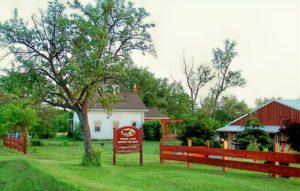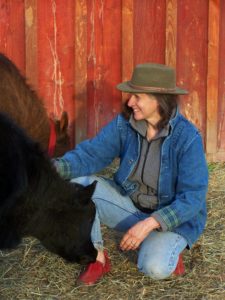Taking a Butter Knife to Kefir Cheese
Rose Belforti of Finger Lakes Dexter Creamery received a second SARE grant to make her newly perfected kefir cheese recipe spreadable.
After Rose Marie Belforti’s four daughters took off for college, she was left with an empty nest and an emerging interest in raising cattle in the countryside. Rose researched breeds and finally landed on the Dexter cow, a mini-cattle breed that can be used both for milk and meat. Out of this, the Finger Lakes Dexter Creamery was born.
What is SARE?
Northeast SARE (Sustainable Agriculture Research and Education) offers grants to farmers, educators, universities and communities that are working to make agriculture more sustainable – economically, environmentally, and socially. Learn about whether a SARE grant would be a good fit for you by visiting www.nesare.org or by contacting Northeast SARE 655 Spear Street University of Vermont, Burlington VT 05405 Phone: (802) 656-0471 Fax: (802) 656 -0500 E-mail: nesare@uvm.edu.
Rose started out as a subsistence farmer, using Dexter cattle to generate only enough milk and meat to support her family. But, as the years passed and the farm grew (Rose jokes that “it seems like we put up a new barn every year”), Rose wanted to expand her farm’s focus. She had always been a proponent of utilizing raw milk as much as possible. She had been producing kefir – a fermented drink made with raw milk and kefir grains which contains 30-50 varieties of living bacteria – since she brought home her first cow. When Rose started to notice a surge of consumer interest in the positive health benefits of probiotic products, like kefir, inspiration took hold. In 2006, she received a SARE ‘Farmer Grant’ which supported the process of scaling up a home kefir recipe to a commercial cheese prototype (see article in Spring 2010 Small Farms Quarterly).

Dexter calves. Dexters are a very small breed of cattle originally from Ireland. They are tri-purpose, great for meat, milk and draft. All photos by Rose Belforti.
Kefir cheese also uses kefir grains to ferment milk, creating a probiotic “living” cheese. Rose says, “Kefir grains propagate naturally when immersed in milk, making them an ideal sustainable natural resource. As they propagate, one can either give them away, save them for later by freezing or drying, or simply eat them!” With the funding Rose received from SARE and the help of a Cornell faculty member, she developed a commercial kefir cheese recipe which she marketed to local stores and at the farmers market.
But Rose still wasn’t satisfied; she wanted to expand her kefir cheese line with a new product. She decided to pursue another SARE grant, this time to refine her existing recipe to develop a recipe for a spreadable kefir cheese that adhered to USDA standards.
Healthy, Spreadable & Delicious
For her second SARE grant, Rose experimented with two main methods of creating a spreadable kefir cheese. While developing both of the methods, Rose had to adhere to USDA requirements that raw milk cheese must age for 60 days and that, at the end of that aging period, the cheese has a moisture content of 44%.
The first of Rose’s methods involved using the recipe for kefir cheese that she had created for her first SARE grant, but instead of aging the cheese naturally, she vacuum-packed it (which helps keep the moisture content of the cheese as high as possible). After the required 60 days of aging, Rose blended together the vacuum-packed cheese and some natural rind-aged cheese to make the cheese as flavorful as possible.

After starting the Finger Lakes Dexter Creamery, Rose Belforti decided she wanted to promote the usage of raw milk by generating kefir cheese recipes.
The second method that Rose employed was much more hands-on; she started with a cheese making vat full of a raw milk and kefir culture brewed from kefir grains, and adjusted her recipe for a spreadable cheese as the cheese aged. Throughout the 60 days of aging, Rose carefully monitored the pH and moisture content of the cheese, adding ingredients such as Holbac (to encourage bacterial growth) and rennet (to acidify) as needed. She created several batches of cheese, tinkering around with the recipe each time, until she had a cheese that both adhered to the USDA’s standards and tasted delectable.
Since developing the spreadable cheese, Rose has continued to craft her cheese line to perfection. She now offers a range of aged cheeses, including kefir Italian pasta cheese, kefir blue, peppercorn cheese, kefir tomato-garlic, kefir salad cheese and kefir wine companion. All offer a different combination of flavors and textures, but whatever the variety, Rose guarentees you’ll taste a pleasant combination of pungent & tangy. The cheeses also can be fancied up for a gourmet meal or eaten as a plain snack. Rose advises, “eat them with fruit, melted on bread, grated, or take them on long walks or commutes for a
wholesome uplifting snack!”
Meanwhile, Rose continues using her cheese and dairy practices to challenge the dairy status quo and highlight the health value of raw unadulterated milk. Rose feels that the best outreach she can do to propagate the usage of raw milk is to, in her words, “put a product out there that other dairy producers can make too.” She has already managed to spread word about how useful raw milk can be through customer interactions at the Ithaca Farmer’s Market and through an open house she hosted at her farm to discuss the basics of kefir cheese and her newest kefir cheese recipe.
For more information, the exact recipe and process of both cheese making methods are available in Rose Belforti’s final report, posted on the SARE website at http://mysare.sare.org/mySARE/ProjectReport.aspx?do=viewRept&pn=FNE10-679&y=2010&t=1 (sare.org > Project Reports > Search Database > project number “FNE10-679”).



